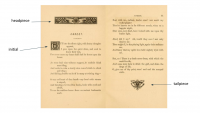Printer's Ornaments
Introduction
Have you ever flipped through a book and noticed stylized and colored letters or borders? Have you ever wondered why they were emphasized? These letters are derivatives of printer’s ornaments, decorations used for both form and function in printing. But what exactly are printer’s ornaments, and why should we care? Through the analysis of two objects pertaining to printer’s ornaments—as well as a miniature case study on a particular printer’s ornament—we will see how the significance of printer’s ornaments has developed and changed between different cultures and time periods.
Printer's Ornaments 101

Printer’s ornaments (other names include wingdings and printer’s flowers) is a fairly all-encompassing term describing printed decorative and stylistic elements used in books that replaced hand-drawn letters and decorations found in early monastic scripts [1] [2]. A more technologically-specific definition refers to printer’s ornaments themselves as wooden or metal letterpress blocks engraved with relief designs for printing alongside the text of a book [2]. There are many different types of printer’s ornaments, the most common being headpieces, tailpieces, and initials that are found on page tops, page bottoms, and section headings, respectively. Printer’s ornaments were carved out of blocks using sharp burins, and either simultaneously printed alongside text or printed in subsequent steps (“A Database”). Printer’s ornaments served a wide variety of purposes in both form and function. They added beauty and color to otherwise black text, and some even provided information towards understanding the text. On a more practical note, printer’s ornaments provided support in empty spaces within a printing frame, thereby preventing warping or distortion of paper and ensuring a certain quality of print (Plomer, 5). Moreover, some printer’s ornaments contained information about the printer as well as the location and year in which the text was printed (Creel, 43).
More Stuff!
Notes
- ↑ Reilly, Elizabeth Carroll. A dictionary of colonial American printer’s ornaments and illustrations. American Antiquarian Society, 1975.
- ↑ 2.0 2.1 Plomer, Henry R. English Printers’ Ornaments. Grafton & Co. Coptic House, 1914. (digitizing sponsored by York University—University of Toronto Libraries)
Reilly, Elizabeth Carroll. A dictionary of colonial American printer’s ornaments and illustrations. American Antiquarian Society, 1975. Plomer, Henry R. English Printers’ Ornaments. Grafton & Co. Coptic House, 1914. (digitizing sponsored by York University—University of Toronto Libraries) Creel, Sarah, “(Re)framing Eliza Haywood: Portraiture, Printer’s Ornaments, and the Fashioning of Female Authorship.” Journal for Early Modern Cultural Studies. Vol. 14., No. 4, University of Pennsylvania Press, 2014. A Database of Eighteenth-Century Printers’ Ornaments. Fleuron: A Database of Eighteenth-Century Printers’ Ornaments, fleuron.lib.cam.ac.uk/index. Album de stampine antiche, Ms. Codex 1859, Kislak Center for Special Collections, Rare Books and Manuscripts, University of Pennsylvania. “Album de stampine antiche.” University of Pennsylvania Finding Aids, http://dla.library.upenn.edu/cocoon/dla/ead/ead.html?start=25&id=EAD_upenn_rbml_PUSpMsCodex1859&